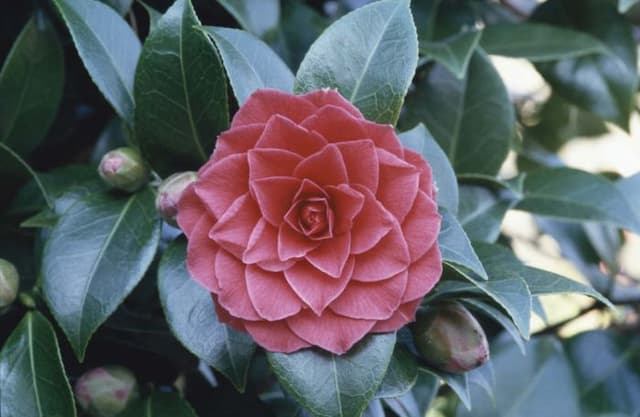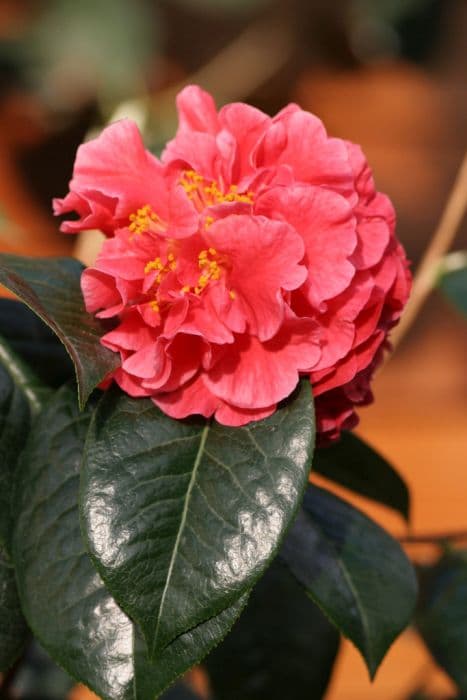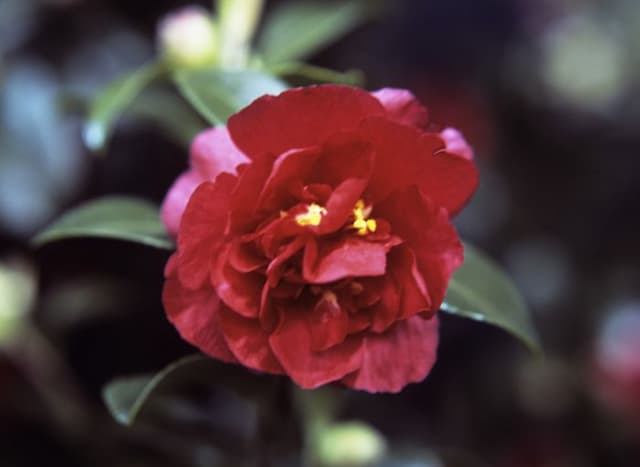Japanese Camellia Camellia 'Shiro-wabisuke' (wabisuke)

ABOUT
The Camellia 'Shiro-wabisuke', commonly known as the wabisuke, is an ornamental shrub known for its distinctive and beautiful blooms. Its flowers are typically pure white, giving a sense of serenity and simplicity. The blossoms have an elegant form, with a central cluster of golden stamens that offers a striking contrast to the white petals. These petals are usually arranged in a somewhat irregular fashion, which adds to the charm and character of the wabisuke. The foliage of the wabisuke is glossy, providing a rich green backdrop that further accentuates the beauty of the flowers. The leaves are typically ovate-shaped, with a smooth, leathery texture. They grow densely on the branches, contributing to the plant's lush, full appearance. Overall, the wabisuke exudes a graceful and delicate beauty, with its pristine flowers and lustrous foliage making it a favorite among gardeners and a visually appealing addition to any landscape.
About this plant
 Names
NamesFamily
Theaceae.
Synonyms
White Wabisuke Camellia, Shiro-Wabisuke Camellia, Snow White Wabisuke.
Common names
Camellia japonica 'Shiro-wabisuke'
 Toxicity
ToxicityTo humans
Camellias are not known to be toxic to humans. Typically, ingesting parts of the camellia plant does not result in poisoning or severe adverse effects. It is always advisable to exercise caution and avoid eating plants that are not explicitly intended for human consumption.
To pets
Camellias are generally considered non-toxic to pets. Ingesting parts of a camellia plant is unlikely to cause serious harm to animals such as dogs and cats. However, ingestion may occasionally result in mild gastrointestinal upset, so keeping an eye on your pet and consulting a veterinarian if any concerning symptoms arise is recommended.
 Characteristics
CharacteristicsLife cycle
Perennials
Foliage type
Evergreen
Color of leaves
Green
Flower color
White
Height
6-10 feet (1.8-3 meters)
Spread
5-8 feet (1.5-2.4 meters)
Plant type
Shrub
Hardiness zones
7
Native area
Asia
Benefits
 General Benefits
General Benefits- Aesthetic Appeal: The wabisuke exhibits delicate white flowers with a gentle and sophisticated appearance that can enhance the beauty of any garden.
- Durable Blooms: The blooms of the wabisuke are long-lasting, providing an extended display of flowers during its blooming season.
- Evergreen Foliage: As an evergreen, the wabisuke retains its glossy, dark green leaves throughout the year, offering consistent foliage and maintaining garden interest even when not in bloom.
- Compact Growth Habit: Its moderate size and compact growth make it suitable for smaller gardens or as part of a mixed border in larger landscapes.
- Shade Tolerance: The wabisuke can thrive in partial shade, making it versatile in various garden locations where direct sunlight is limited.
- Cultural Significance: The plant has cultural relevance in Japan, where it is often associated with the aesthetic concept of 'wabi-sabi,' embodying simplicity and tranquility.
- Attracts Pollinators: The flowers can attract bees and other pollinators, contributing to the health of your garden's ecosystem.
- Low Maintenance: Once established, the wabisuke is relatively low maintenance, requiring minimal care compared to other flowering shrubs.
- Year-Round Interest: With its evergreen nature and sturdy blooms, the wabisuke provides interest throughout all seasons.
- Resilience: The plant is hardy and can withstand a variety of growing conditions once established, making it a reliable choice for gardeners.
 Medical Properties
Medical PropertiesThis plant is not used for medical purposes.
 Air-purifying Qualities
Air-purifying QualitiesThis plant is not specifically known for air purifying qualities.
 Other Uses
Other Uses- Crafting Bonsai: The Camellia can be trained to grow as a bonsai, offering an aesthetically pleasing miniature representation of a full-sized tree.
- Dye Production: Leaves from the Camellia plant may be used to create plant-based dyes for fabrics and textiles.
- Cosmetics: Oil extracted from the seeds of Camellia is often used in skincare and haircare products.
- Culinary Garnish: The petals of Camellia flowers can be used to add a decorative touch to dishes and desserts.
- Tea Ceremony Accents: In Japan, Camellia flowers are commonly used as a traditional decoration in tea ceremonies.
- Photography Subject: With their striking beauty, Camellias are a popular subject for botanical photographers.
- Floral Arrangements: Camellia blooms and foliage are used in floral arrangements for their elegance and long-lasting qualities.
- Religious and Symbolic Uses: In certain cultures, Camellias are used in religious ceremonies or as symbols of love and devotion.
- Landscape Design: Camellia plants are valued for their year-round foliage and use in structured garden designs.
- Ink Production: Historically, the tannins in Camellia leaves have been used in ink production for writing and artwork.
Interesting Facts
 Feng Shui
Feng ShuiThe Camellia is not used in Feng Shui practice.
 Zodiac Sign Compitability
Zodiac Sign CompitabilityThe Camellia is not used in astrology practice.
 Plant Symbolism
Plant Symbolism- Perfection: Often associated with the ideal or excellence, as the Camellia blooms are nearly perfect geometrically.
- Adoration: The Camellia is a symbol of adoration and admiration, making it a popular gift for loved ones.
- Longevity: With their capability to live for many years, Camellias represent the endurance of life.
- Purity: The white color of Shiro-wabisuke Camellias signifies purity and innocence.
 Water
WaterJapanese camellias, including the Camellia 'Shiro-wabisuke', prefer to be watered regularly, ensuring the soil remains moist but not waterlogged. Water the plant with approximately 1 gallon per week during the growing season, reducing the frequency during dormant winter months. Incrementally increase watering if the plant is in full sun or during particularly dry periods, making sure to adjust to the moisture needs identified by checking the topsoil dryness. Ensure adequate drainage to avoid root rot as these plants are sensitive to overly wet conditions.
 Light
LightCamellia 'Shiro-wabisuke' thrives in partial shade to dappled sunlight, which mimics its natural understory habitat. Aim to position the plant where it will be shielded from the intense midday sun but can receive morning or late afternoon light. An eastern or northern exposure is typically ideal, providing the delicate balance of light required for optimal growth and bloom production.
 Temperature
TemperatureOptimal growth for Camellia 'Shiro-wabisuke' occurs in temperatures ranging from 50 to 70 degrees Fahrenheit. Although it can tolerate brief dips down to around 20 degrees, sustained exposure to freezing conditions can be damaging. They are best suited to USDA hardiness zones 7 through 9, where temperature extremes are less likely to impact the plant adversely.
 Pruning
PruningPrune Camellia 'Shiro-wabisuke' after flowering to maintain shape and encourage bushier growth. Light pruning is often enough, focusing on removing dead or weak branches, while hard pruning can rejuvenate an older plant. The best time to prune is in late winter or early spring before the onset of new growth. Regular removal of spent flowers and crossing branches improves air circulation and plant health.
 Cleaning
CleaningAs needed
 Soil
SoilCamellias require acidic soil with a pH between 5.5 and 6.5. The best soil mix for Camellia 'Shiro-wabisuke' consists of 1/3 organic matter (like pine bark or leaf mold), 1/3 peat moss, and 1/3 perlite or sand to improve drainage. This mix ensures proper aeration and moisture retention, crucial for healthy growth.
 Repotting
RepottingCamellia 'Shiro-wabisuke' should be repotted every 2-3 years, or when the roots outgrow the pot. It's best to repot in the spring, just before the growing season begins, ensuring minimal stress on the plant.
 Humidity & Misting
Humidity & MistingCamellias thrive in moderate to high humidity. Camellia 'Shiro-wabisuke' prefers a humidity level around 40-60%. If indoor air is too dry, consider using a humidifier or placing the pot on a tray of wet pebbles to increase ambient moisture.
 Suitable locations
Suitable locationsIndoor
Ensure bright, indirect light and maintain high humidity for Camellia 'Shiro-wabisuke'.
Outdoor
Place in dappled shade, protect from strong winds for Camellia 'Shiro-wabisuke'.
Hardiness zone
7-9 USDA
 Life cycle
Life cycleCamellia 'Shiro-wabisuke', commonly known as Wabisuke Camellia, begins its life cycle when a seed germinates in well-drained, acidic soil with dappled sunlight. As a seedling, it pushes through the soil surface and begins to develop a primary root and foliage. Over several years, the plant enters into a vegetative stage, characterized by the growth of glossy, evergreen leaves and the development of a woody stem structure. When mature, typically after a few years, the Wabisuke Camellia produces large, white, fragrant flowers during late winter to early spring, attracting pollinators which facilitate cross-pollination. After pollination, the flowers develop into seed pods (fruit) that mature by autumn and release seeds, continuing the reproductive cycle. The plant can live several decades, during which it will flower annually, gradually growing into a large shrub or a small tree.
 Propogation
PropogationPropogation time
Early Spring
The Camellia 'Shiro-wabisuke', commonly known as the Wabisuke camellia, is typically propagated during late winter to early spring before new growth starts. The most popular method of propagation for this plant is by semi-hardwood cuttings. To do this, a gardener would select healthy, semi-hardwood stems that have matured after the flush of spring growth. A section of the stem about 4 to 6 inches long with several leaves is cut and the lower leaves are removed. The cut end is then dipped in rooting hormone powder to encourage root development and planted in a pot filled with a well-draining growing medium, such as a mix of peat and perlite. The pot is kept under high humidity conditions, either in a greenhouse or under a plastic tent, and maintained at a temperature around 70 to 75 degrees Fahrenheit (21 to 24 degrees Celsius). With proper care, roots should develop within a few months, after which the new Wabisuke camellia plant can be transplanted to a more permanent location.









